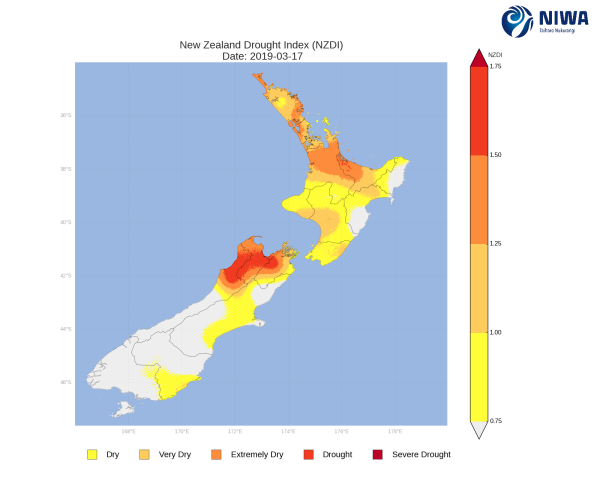A weekly update describing soil moisture across the country to help assess whether severely to extremely dry conditions are occurring or imminent. Regions experiencing these soil moisture deficits are deemed “hotspots”. Persistent hotspot regions have the potential to develop into drought.
Facts: Soil Moisture
Across the North Island, soil moisture levels generally decreased during the past week due to below normal rainfall amounts. The most significant decreases were observed in eastern Northland and across much of the east coast, with other notable decreases occurring in Bay of Plenty and northern Waikato. The driest soils across the North Island compared to normal for this time of the year are found in eastern Northland, northern Waikato, and Bay of Plenty, while the wettest soils for this time of the year are located near Wellington City.
Hotspots are now located across the majority of Northland, Auckland, northern Waikato, and interior Bay of Plenty, as well as central Manawatu-Whanganui and Napier south to Wairarapa.
In the South Island, soil moisture levels increased significantly across Nelson, Tasman, and Buller District during the past week. Elsewhere, soil moisture generally decreased slightly along the east coast and in Southland, with small increases observed in the West Coast and interior Otago. The driest soils across the South Island compared to normal for this time of the year are now found in lower Southland and Stewart Island, while the wettest soils for this time of the year are found in Marlborough Sounds and a small portion of northern Otago.
South Island hotspots are now located in a portion of interior Marlborough, eastern Banks Peninsula, and the lower Southland coast.
Outlook and Soil Moisture
In the North Island, rainfall amounts over the next several days will be sparse as high pressure remains in control. However, an easterly wind flow will bring a few light showers to eastern-facing locations as well as the Bay of Plenty through the upcoming weekend (23-24 March), although total rainfall amounts will likely remain below 10 mm through to early next week. There is a possibility that a moisture-rich front moving north from the South Island will impact the North Island on Wednesday or Thursday next week (27-28 March), which could bring rainfall amounts of 15-30 mm. However, the passage of this front remains uncertain at this time.
Should the aforementioned front reach the North Island during the middle of next week, at least minor soil moisture improvements would be expected for most areas, potentially weakening the hotspots currently in place. However, if this front does not eventuate, soil moisture levels would continue to decrease across the North Island.
In the South Island, dry weather is anticipated through to Saturday (23 March). However, early next week moderate to heavy rain will impact the West Coast. The heaviest rain is likely to occur on Tuesday and Wednesday (26-27 March) as an atmospheric river moves across the Tasman Sea from Australia, with rainfall amounts possibly in excess of 300 mm along the western slopes of the Southern Alps. Such heavy rainfall will result in flooding concerns for the West Coast next week. Meanwhile, rainfall amounts from this same event will be far less from Southland to Canterbury, where totals of 25-50 mm will be possible. Northern Canterbury and Marlborough could receive up to 25 mm of rain, with up to 30-40 mm near Nelson.
With the heavy rain expected next week, soils will likely become wetter than normal in the western South Island along with the risk of flooding. Soil moisture levels should improve nearly everywhere else in the South Island as well, shrinking or eliminating the current hotspots.
Background:
Hotspot Watch a weekly advisory service for New Zealand media. It provides soil moisture and precipitation measurements around the country to help assess whether extremely dry conditions are imminent.
Soil moisture deficit: the amount of water needed to bring the soil moisture content back to field capacity, which is the maximum amount of water the soil can hold.
Soil moisture anomaly: the difference between the historical normal soil moisture deficit (or surplus) for a given time of year and actual soil moisture deficits.
Definitions: “Extremely” and “severely” dry soils are based on a combination of the current soil moisture status and the difference from normal soil moisture see soil moisture maps.
Hotspot: A hotspot is declared if soils are "severely drier than normal" which occurs when Soil Moisture Deficit (SMD) is less than -110 mm AND the Soil Moisture Anomaly is less than -20 mm.



